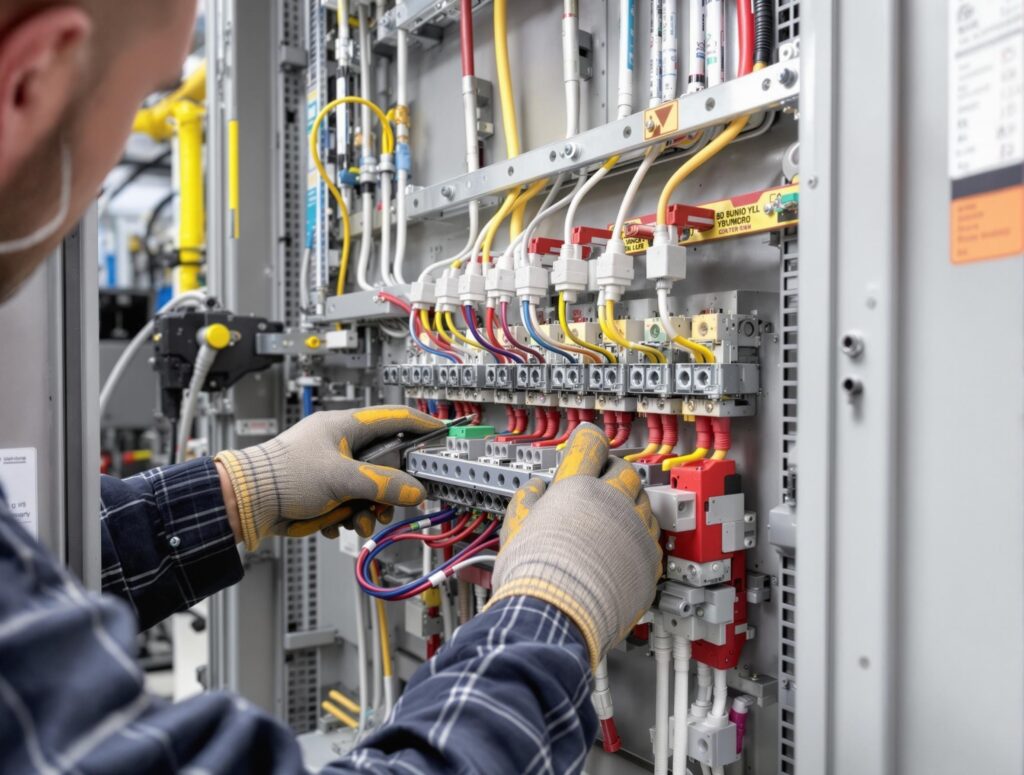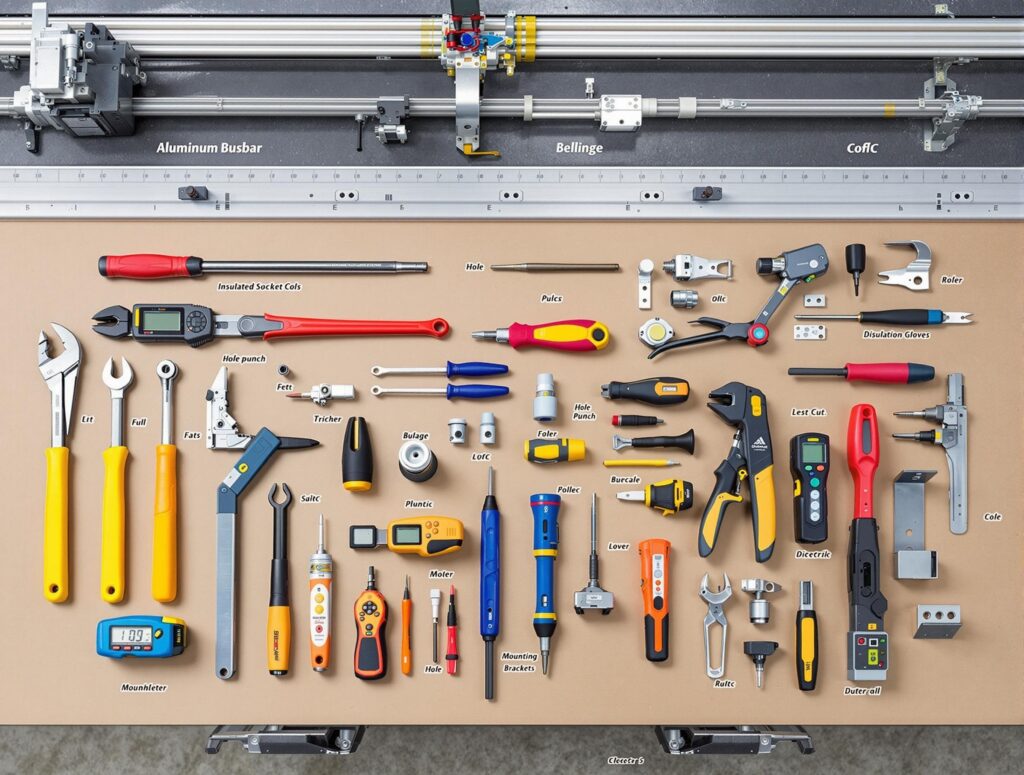Installation Tips for Aluminum Busbar Systems: Aluminum Bus Bar, Aluminium Busbars, and Busbar Trunking
Welcome to the AP Precision Metals guide on installation tips for aluminum busbar systems. This section will provide practical advice and expert recommendations for installing aluminum bus bars, aluminum busbars, and busbar trunking efficiently and effectively. Ensuring proper installation enhances system performance and longevity, reducing maintenance costs and operational downtime. Explore tips to achieve seamless integration and optimal functionality in your electrical applications.
Installation Instructions for Aluminum Bus Bars in Electrical Systems
When it comes to installing aluminum bus bars in electrical systems, it’s crucial to adhere to specific guidelines to ensure optimal performance and safety. Installing an aluminum bus bar system involves multiple steps, ranging from proper mounting and assembly to ensuring low resistance at contact points. They will provide a detailed overview of the essential steps in installing aluminum bus bars.
First, preparation is key. Begin by carefully inspecting your aluminum bus bars and related components to ensure no damage occurred during shipping. Proper handling is essential to avoid any bends or nicks that could affect the electrical and structural integrity of the bus bars. Ensure you have all the necessary tools and equipment, including bus bar trunking systems, adequate mounting hardware, and protective gear. As you’ll learn in the next section on essential tools for installing aluminum busbar systems, having the right equipment can significantly streamline the installation process.
The next step is to plan the layout of your aluminum bus bar system. Accurate layout planning helps minimize resistance and ensures that all electrical contacts are secure. Measure the required lengths carefully, considering any bends or turns the bus bars need to make. Once the layout is confirmed, start by installing the main support structures. Securely mounting the support structures is fundamental to the overall stability of your system.
With your support structures in place, you can begin the assembly process. Attach the aluminum bus bars to these supports utilizing appropriate hardware. It’s important to follow the recommended torque settings to ensure the connections are neither too tight nor too loose, as improper torque can lead to increased electrical resistance or mechanical failure. Pay special attention to the cleanliness of the contact surfaces. Any debris or oxidation can significantly impact the electrical efficiency of the system.
Next, make sure all electrical joints are thoroughly bolted and tightened to maintain optimal contact. Anti-oxidation compounds can help maintain the integrity of these joints by preventing the formation of oxides, which increase resistance. As part of your maintenance routine, routinely check these joints for signs of wear and corrosion.
Electrical testing is an integral part of the installation process. To verify the integrity of the assembled system, perform comprehensive continuity tests and measure the voltage drops across all bus bar connections. Documenting these results can be beneficial for future maintenance activities and troubleshooting.
Lastly, always adhere to local and national electrical codes and standards. Compliance ensures the efficiency and durability of your aluminum bus bar systems, and the safety of everyone involved. Always consult a licensed electrical engineer to review your installation plans and validate the electrical load calculations for your bus bars and bus bar trunking systems.
You can achieve a robust, high-performance aluminum bus bar system by following these installation tips. In the upcoming section, delve into the essential tools for installing aluminum busbar systems and compare aluminum and copper busbars for optimal electrical performance. Thank you for choosing AP Precision Metals for your high-quality bus bar products.
Essential Tools for Installing Aluminum Busbar Systems
When installing aluminum busbar systems, having the right tools at your disposal makes a significant difference in ensuring a seamless and reliable installation process. AP Precision Metals has compiled a comprehensive list of essential tools required to install aluminum bus bars, aluminum busbars, and busbar trunking in electrical systems. These tools facilitate the installation and ensure the longevity and performance of the electrical system’s components.
A high-quality torque wrench is a crucial tool for installing aluminum busbar systems. This tool ensures that bolts are tightened to the manufacturer’s specifications, preventing under-tightening and over-tightening, which can lead to potential failures or maintenance issues. The application of appropriate torque is critical in maintaining the integrity of the aluminum busbar installations and ensuring optimal electrical connectivity.
Another indispensable tool is a set of insulated cable cutters and strippers. These tools are specifically designed for electrical installations and ensure that cables are cut and stripped safely and accurately. Properly prepared cables are vital for the secure attachment to the aluminum busbar systems, directly affecting the system’s performance and safety.
Heat guns are also essential tools in the installation of aluminum busbar systems. They are used to heat shrink tubing and insulation materials around connections, providing additional protection and insulation. The application of heat ensures a tight, secure fit of these materials, which helps prevent electrical faults and extend the system’s lifespan.
Additionally, having a reliable set of drill drivers and bits is crucial for creating precise holes in mounting surfaces and enclosures. This precision is necessary for the correct placement of aluminum busbars and the subsequent installation of bolts and other fastening hardware. Drilling accuracy helps in aligning the bus bars properly, which is fundamental to the stability and efficiency of the entire electrical system.
A digital multimeter is another essential tool for any installation of aluminum busbar systems. This device allows electricians to measure voltage, current, and resistance, thus verifying that all electrical connections are secure and functioning correctly. Multimeters are vital for troubleshooting and ensuring the reliability of installations, particularly in complex electrical systems.
Lastly, protective gear should never be overlooked. Insulated gloves, safety glasses, and protective clothing are mandatory when performing any electrical installations. Ensuring all personnel are equipped with the proper safety gear minimizes the risk of electrical shocks and other hazards associated with installing aluminum busbar systems.
Equipping yourself with these essential tools ensures that your installation of aluminum busbar systems, aluminum busbars, and busbar trunking is executed efficiently and safely. AP Precision Metals understands the importance of using the right tools for the job and strives to provide its clients with the highest level of service and expertise in every aspect of electrical installations.
Comparing Aluminum and Copper Busbars for Optimal Electrical Performance
When it comes to electrical systems, the choice between aluminum busbars and copper busbars can significantly impact performance, reliability, and cost. Both materials have distinct advantages and characteristics that make them suitable for varying applications. AP Precision Metals understands that selecting the right busbar material is crucial for optimizing your electrical system’s efficiency and reliability.
Aluminum bus bars are renowned for their lightweight nature and excellent conductivity. One of the primary benefits of using aluminum in busbar systems is its cost-effectiveness. Aluminum is considerably cheaper than copper, making it a preferred choice for large-scale electrical installations where budget is a critical factor. Another advantage is the weight; aluminum bus bars are roughly one-third the weight of copper busbars, which eases the installation process and reduces the mechanical stress on supporting structures during busbar trunking installation.
Moreover, aluminum’s inherent resistance to oxidation adds to its durability, ensuring a prolonged lifespan even in harsh environments. While aluminum may require a larger cross-sectional area than copper to achieve the same conductivity, advances in engineering and design have minimized these differences, making it an increasingly attractive option for modern electrical systems. Companies seeking a quote or post-installation support often lean toward aluminum due to these combined benefits.
On the other hand, copper has been the traditional choice for busbars in electrical systems for many years. The high conductivity of copper ensures minimal energy loss, which is essential for high-performance applications where efficiency is paramount. Additionally, copper’s mechanical strength enables it to withstand high thermal and electrical loads without deforming, contributing to the overall reliability of the electrical system. Copper’s superior current-carrying capacity and lower resistance mean that it can manage higher loads more efficiently, making it ideal for critical infrastructure and industrial applications.
However, the downside of using copper in busbar systems is its cost. Copper is significantly more expensive than aluminum, which can substantially increase the overall project budget. Furthermore, copper’s higher density translates into heavier bus bars, which can complicate the busbar trunking installation process and demand more robust support structures. This is a critical point for companies weighing the trade-offs between material performance and installation feasibility.
AP Precision Metals recognizes the importance of tailoring the right material to a project’s specific needs. Whether clients prefer the lightweight and cost-effective nature of aluminum bus bars or the high performance and reliability of copper, their team of specialists can provide the expertise needed to ensure optimal electrical performance. They offer detailed consultations and precise quotes to help their clients make informed decisions that suit their electrical systems’ unique requirements.
In conclusion, aluminum and copper busbars have distinct advantages and potential drawbacks. The choice largely depends on the installation’s specific requirements, including budget constraints, mechanical stress considerations, and desired electrical performance. With AP Precision Metals, you can be assured of receiving high-quality products and expert guidance for your busbar systems, whether you opt for aluminum or copper. Contact AP Precision Metals today for a detailed quote and to discuss how they can support your next electrical installation project with precision and reliability.
Adhering to these installation tips can ensure enhanced performance and longevity of your aluminum busbar systems. AP Precision Metals is committed to providing top-quality aluminum bus bars and busbar trunking solutions that meet the highest industry standards. For further assistance or to explore the range of products, please contact them today. Proper installation is crucial, and AP Precision Metals is here to support you every step of the way.
FAQs
Q: What are the initial steps I should take when preparing to install aluminum bus bars in my electrical system?
A: Preparation is vital for the successful installation of aluminum bus bars. Begin by inspecting all components for any damage incurred during shipping. Ensure proper handling to avoid bends or nicks that could compromise electrical and structural integrity. Gather all necessary tools, mounting hardware, and protective gear before proceeding.
Q: How should I plan the layout for aluminum busbar systems?
A: Accurate layout planning is crucial for minimizing resistance and ensuring secure electrical contacts. Measure the required lengths carefully, account for bends and turns, and install the main support structures securely. Proper planning helps in achieving optimal functionality and stability for the entire system.
Q: What tools are essential for installing aluminum busbar systems?
A: Essential tools include a high-quality torque wrench, insulated cable cutters and strippers, heat guns, drill drivers with bits, digital multimeters, and protective gear like insulated gloves and safety glasses. These tools facilitate safe, accurate, and efficient installation, ensuring the longevity and performance of the system.
Q: How do I ensure optimal contact and minimize resistance at electrical joints?
A: Ensure that all electrical joints are thoroughly bolted and tightened according to the recommended torque settings. Use anti-oxidation compounds to prevent the formation of oxides, which can increase resistance. Regularly check these joints for signs of wear and corrosion as part of your maintenance routine.
Q: What are the key considerations when choosing between aluminum and copper bus bars?
A: Aluminum bus bars offer cost-effectiveness and lightweight, making them suitable for large-scale installations with budget constraints. They also exhibit good conductivity and resistance to oxidation. Copper bus bars, while more expensive and heavier, provide superior conductivity and mechanical strength, making them ideal for high-performance applications. The choice depends on specific project requirements, including budget, mechanical stress, and desired electrical performance. Always consult with a licensed electrical engineer to make an informed decision.
For more information or assistance with your aluminum busbar installation, feel free to contact AP Precision Metals. They are dedicated to providing high-quality products and expert guidance for your electrical systems.


